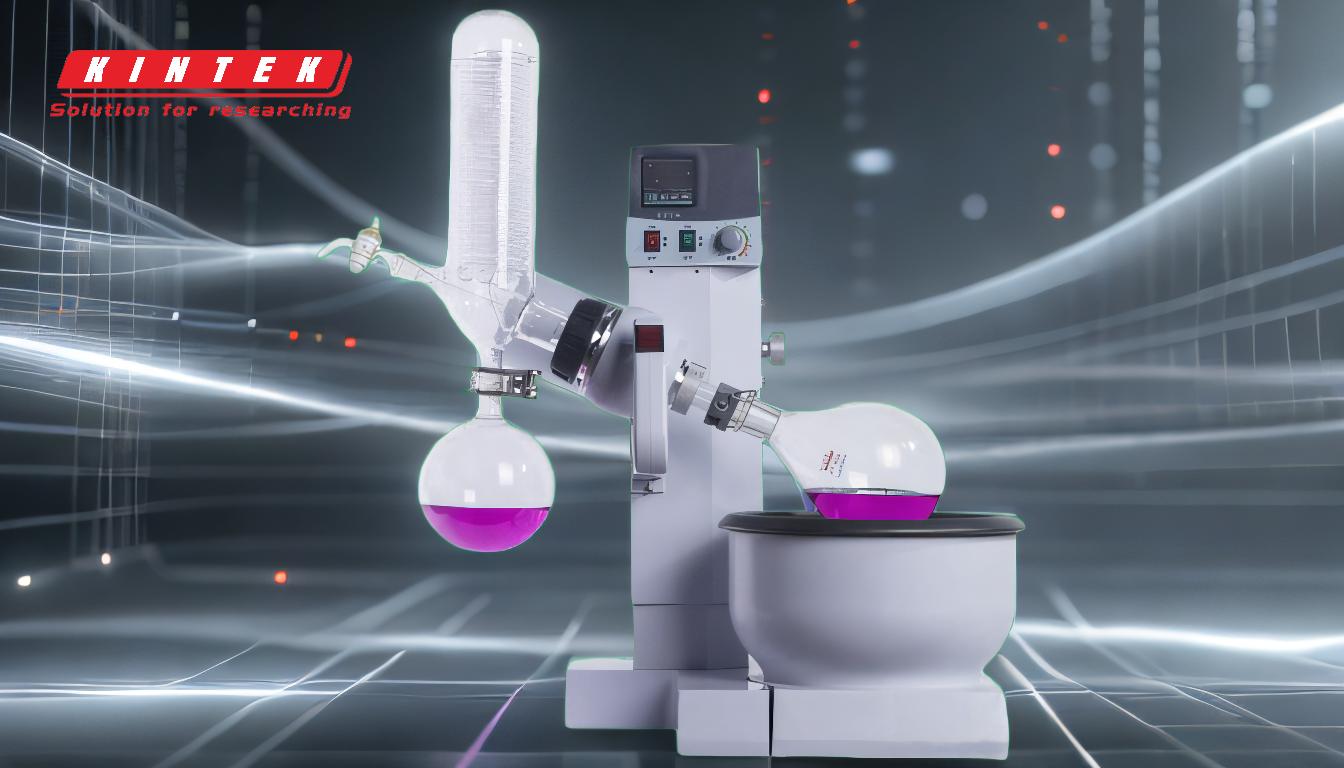Rotary evaporation (Rotovap) is a widely used technique in laboratories for solvent removal, particularly when dealing with water or other solvents. The process relies on reducing the pressure to lower the boiling point of the solvent, allowing it to evaporate at lower temperatures. For water removal, specific conditions must be met to ensure efficient and safe operation. These include maintaining appropriate temperature and pressure ranges, ensuring the desired compound does not form an azeotrope with water, and using suitable equipment such as a vacuum pump, condenser, and temperature-controlled bath. Understanding these conditions is critical for achieving effective separation and avoiding issues like bumping or incomplete solvent removal.
Key Points Explained:

-
Boiling Point and Azeotrope Formation:
- Lower Boiling Point Requirement: For effective rotary evaporation, the desired compound (e.g., water) must have a lower boiling point than the solvent or mixture it is being separated from. This ensures that the solvent evaporates preferentially under reduced pressure.
- Azeotrope Avoidance: The compound should not form an azeotrope with the solvent. Azeotropes are mixtures that evaporate at a constant boiling point, making separation difficult. If water forms an azeotrope with the solvent, rotary evaporation may not be effective.
-
Temperature and Pressure Conditions:
- Temperature Range: For water removal, temperatures between 25°C and 50°C are typically sufficient. Lower temperatures slow the evaporation process but reduce the risk of bumping (sudden boiling that can cause splashing).
- Pressure Requirements: A low-vacuum pump or sink aspirator is often adequate for water removal. The pressure must be adjusted to achieve the desired boiling point. For example, boiling water at 30°C requires a pressure of approximately 42 mbar, while boiling at 25°C requires around 32 mbar.
- 20/40/60 Rule: This rule suggests setting the bath temperature about 20°C higher than the desired vapor temperature and the condenser temperature about 20°C lower. For water, this means a bath temperature of around 45–50°C and a condenser temperature of 5–10°C.
-
Equipment Requirements:
- Vacuum Pump: A low-vacuum pump or sink aspirator is sufficient for most water removal tasks. However, for higher boiling solvents or more demanding applications, a high-quality vacuum pump may be necessary.
- Condenser: A chiller or cooling system is required to condense the evaporated water. For water, the condenser temperature is typically set to around 0°C.
- Temperature-Controlled Bath: The water bath should be capable of maintaining a stable temperature within the desired range (25–50°C).
- Collection Bottle: A collection flask is needed to capture the condensed water.
-
Process Optimization:
- Bumping Prevention: Lower temperatures and gradual pressure reduction can minimize bumping. Using a manometer to monitor pressure and a distillation nomograph to calculate boiling points can help optimize the process.
- Efficiency Considerations: While lower temperatures reduce the risk of bumping, they also slow the evaporation rate. Balancing temperature and pressure is key to achieving efficient water removal without compromising safety or quality.
-
Applications Beyond Water:
- While water is a common target for rotary evaporation, the technique can also be applied to higher boiling solvents like DMF (dimethylformamide) or DMSO (dimethyl sulfoxide) with a high-quality vacuum pump. However, water removal is often simpler due to its relatively low boiling point and lack of azeotrope formation with many solvents.
By adhering to these conditions, rotary evaporation can be a highly effective method for removing water from mixtures in laboratory settings. Proper equipment setup, temperature and pressure control, and an understanding of the chemical properties of the solvent and compound are essential for success.
Summary Table:
| Key Factor | Details |
|---|---|
| Boiling Point | Ensure water has a lower boiling point than the solvent. |
| Azeotrope Formation | Avoid azeotropes to ensure effective separation. |
| Temperature Range | Maintain 25–50°C for water removal. |
| Pressure Requirements | Use a low-vacuum pump (e.g., 32–42 mbar for 25–30°C boiling). |
| Equipment | Vacuum pump, condenser (0°C), temperature-controlled bath, collection flask. |
| Process Optimization | Prevent bumping with gradual pressure reduction and lower temperatures. |
Need help optimizing your rotary evaporation process? Contact our experts today for tailored solutions!













